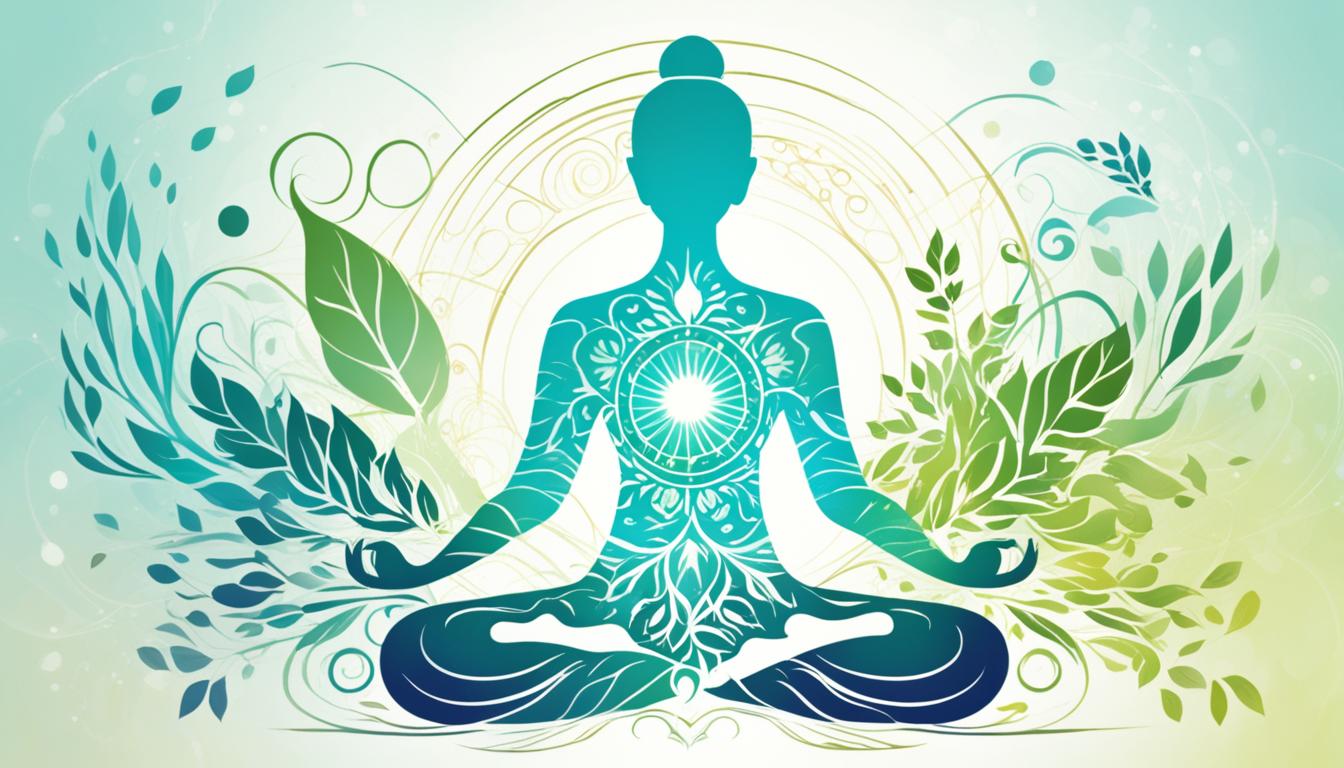Welcome to a journey of self-discovery and inner peace through the power of meditation words. In this article, we will explore how incorporating specific words into your practice can deepen your understanding and enhance your meditation experience. Whether you are new to meditation or a seasoned practitioner, these meditation words will help you find mindfulness, relieve stress, and cultivate relaxation.
Imagine the ability to tap into profound states of tranquility and calmness by simply focusing on a single word. These words act as anchors, guiding you towards a more peaceful and mindful existence. They can be used in various ways, such as in guided meditation sessions or silent repetition during personal practice.
Discover the transformative potential of meditation words and incorporate them into your daily routine. With these powerful tools, you can unlock the full benefits of mindfulness techniques and find serenity amidst the chaos of everyday life. Start your journey towards inner peace today.
Key Takeaways:
- Discover the power of meditation words to enhance your practice and deepen your understanding.
- Meditation words can guide you towards mindfulness, relieving stress and promoting relaxation.
- Use these words in guided meditation or repetitive practice for a more profound experience.
- Incorporate meditation words into your daily routine for transformative effects on your overall well-being.
- Start your journey towards inner peace and self-discovery today with the help of meditation words.
The Power of Presence in Meditation
Presence is the key to unlocking the true potential of your meditation practice. It is the state of being fully engaged and aware of the current moment, allowing you to experience the richness of each breath and sensation without distraction or judgment. By cultivating presence, you let go of the past and future, immersing yourself in the present moment.
Imagine sitting in meditation, feeling the gentle rise and fall of your chest as you breathe, fully aware of the sensations in your body. Your mind is calm, focused, and free from wandering thoughts. In this state of presence, you are truly in tune with yourself and your surroundings.
Mindfulness plays a vital role in cultivating presence. It is the practice of paying attention to the present moment, non-judgmentally and with acceptance. When you approach your meditation practice with mindfulness, you become an observer of your thoughts, feelings, and bodily sensations without getting caught up in them.
Being fully engaged in the present moment allows you to let go of stress, worries, and distractions. It opens the door to deep relaxation and inner peace. As you experience the now with full presence, you may notice a profound sense of clarity and connection.
So how can you enhance your presence in meditation? One technique is to focus on your breath. As you inhale and exhale, bring your attention solely to the sensation of the breath entering and leaving your body. By anchoring your awareness in the breath, you anchor yourself in the present moment.
Another way to cultivate presence is through body scan meditation. This involves systematically bringing your attention to different parts of your body, noticing any sensations or areas of tension. By doing so, you bring yourself fully into your body and the present moment.

Remember, presence is not about achieving a certain state of mind, but rather about being open and receptive to the present moment. By practicing presence in meditation, you can cultivate a greater sense of peace, clarity, and connection in your daily life.
Cultivating Tranquility in Meditation
Tranquility in meditation refers to a deep state of calmness and inner peace. It is the serenity that arises when you let go of chaotic thoughts and emotions. Achieving tranquility can be done through focusing on slow, deep breathing, visualization, or repeating calming mantras.
When you practice meditation with the intention of cultivating tranquility, you create a safe space within yourself to let go of the stresses and anxieties of everyday life. By bringing your attention to the present moment and releasing any tension or unease, you allow a sense of calmness to flow through your body and mind. This tranquility can provide a sanctuary in which you can find solace and relief from the pressures of the outside world.
One effective technique for cultivating tranquility is to focus on your breath. Take slow, deep breaths, filling your lungs with air and then exhaling gently. As you do this, imagine inhaling tranquility and exhaling any stress or tension. Feel the calmness spreading throughout your body with each breath, creating a sense of ease and peacefulness.
Visualization is another powerful method for accessing tranquility. Close your eyes and imagine yourself in a serene natural setting, such as a peaceful beach or a tranquil forest. Use all your senses to create a vivid mental image of this peaceful scene. Feel the warmth of the sun on your skin, hear the gentle sounds of nature, and smell the fragrance of the surroundings. Immerse yourself in this visualization, allowing the tranquility of the scene to permeate your being.
“Tranquility is not just the absence of chaos; it is the presence of inner peace.”
Repeating calming mantras can also help to cultivate tranquility. Choose a word or phrase that resonates with you and brings a sense of calmness. You can silently repeat this mantra during your meditation practice, allowing its soothing vibrations to fill your consciousness and bring you a deeper sense of tranquility.
By incorporating the word “tranquility” into your meditation practice, you create an intentional focus on cultivating a more peaceful state of mind. This focus on tranquility can help to quiet the mind, reduce stress, and promote inner peace. It allows you to tap into a deeper sense of emotional resilience and well-being, enhancing your overall quality of life.

Summary
Cultivating tranquility in meditation is an essential practice for finding calmness and inner peace. Through techniques such as focused breathing, visualization, and repeating calming mantras, you can create a sanctuary of tranquility within yourself. This intentional focus on tranquility brings about a sense of calmness, reduces stress, and promotes emotional resilience. Incorporate the word “tranquility” into your meditation practice today and experience the profound benefits of cultivating inner serenity.
The Importance of Awareness in Meditation
Awareness is a fundamental aspect of meditation that plays a crucial role in enhancing your practice. It directs your attention to the present moment, allowing you to cultivate a deeper understanding of yourself and the world around you.
Being aware means consciously observing your thoughts, feelings, and bodily sensations without judgment or attachment. It involves immersing yourself in the present moment, fully engaged and curious about your experience.
“Observation is the key that unlocks the door of awareness.”
By developing awareness in meditation, you gain insights into the patterns of your mind and emotions. This observation helps you detach from negative or harmful thoughts, allowing you to respond to them with compassion and understanding.
Awareness extends beyond the meditation cushion and into your daily life. As you become more mindful of your thoughts and reactions, you can choose to respond rather than react impulsively. This intentional living brings greater clarity, emotional balance, and a sense of calmness into your day-to-day experiences.
To practice awareness in meditation, find a quiet space, sit comfortably, and focus your attention on your breath. As thoughts arise, observe them without judgment, allowing them to come and go. Notice any sensations in your body, the sounds around you, and bring your attention back to the present moment whenever your mind wanders.
“Being fully present in the moment is a gift you can give yourself every day.”
As you continue to cultivate awareness in your meditation practice, you will gradually expand your capacity for self-reflection, self-compassion, and a deeper connection to yourself and others.

Cultivating Compassion in Meditation
Compassion is a profound aspect of meditation that invites you to develop a sense of empathetic understanding and kindness towards yourself and others. It is a practice that recognizes the suffering of others and fosters a genuine desire to alleviate it. By incorporating compassion into your meditation practice, you can cultivate emotional well-being, promote harmonious relationships, and adopt an empathetic approach to life’s challenges.
During your meditation sessions, focus on generating feelings of love and kindness towards yourself. Acknowledge your own struggles and emotions with compassion, allowing yourself to experience healing and self-acceptance. Gradually extend these feelings of compassion to others in your life, including loved ones, acquaintances, and even those with whom you may have challenges.
As you deepen your practice of compassion, you will find that it not only brings relief to others but also uplifts your own spirit. The act of showing kindness and empathy towards others creates a positive ripple effect in both your internal and external world, fostering a sense of connection and unity.
Practicing compassion in meditation is a powerful tool for alleviating suffering, both within yourself and in the world around you. By incorporating this practice into your daily life, you can unlock the transformative potential of compassion, enhancing your emotional well-being and nurturing a more compassionate existence.
Image:

Seeking Harmony and Balance in Meditation
Harmony refers to the balance and unity between the mind, body, and spirit in meditation. It involves aligning your inner self with the outer world, creating a sense of peace and coherence in your life. When you strive for harmony, you seek to find a state of equilibrium that encompasses your entire being.
There are various techniques that can help you achieve harmony in your meditation practice. Mindful breathing allows you to focus on your breath, bringing your attention to the present moment and calming your mind. Chanting mantras or using affirmations can also be powerful tools for bringing balance to your mind, body, and spirit.
In addition, movement meditations such as yoga or Tai Chi can promote a sense of harmony by integrating physical movement with breath and mindfulness. These practices help you cultivate a deeper connection with yourself and the world around you.
By focusing on harmony in your meditation, you are fostering a more balanced approach to life’s challenges. You are nurturing your mind, body, and spirit, promoting holistic well-being and inner peace. As you continue to cultivate harmony, you will experience greater clarity, personal growth, and a profound sense of inner fulfillment.

Embrace the power of harmony in your meditation practice and embark on a transformative journey towards inner peace and balance.
Conclusion
Incorporating meditation words into your practice can be transformative, unlocking the doors to a more mindful and self-aware existence. These profound concepts provide a pathway to explore the depths of your mind and heart, leading to greater inner peace, self-discovery, and enhanced mindfulness.
Whether you seek tranquility, harmony, or insight, these meditation words serve as guideposts in your journey. By incorporating them into your daily practice, you can pave the way for a more profound and fulfilling experience of meditation.
Start using meditation words today and witness the benefits firsthand. From guided meditation sessions to mental clarity exercises and breathing techniques, the power of these words can bring about a deeper connection with yourself and the world around you. Discover the transformative potential of meditation words and enhance your practice to new heights. Embrace the profound impact they can have on your meditation journey.
FAQ
What are meditation words?
Meditation words are powerful tools used in meditation that can deepen understanding and enhance the practice. They act as anchors, guiding practitioners towards specific states of mind and experiences.
How can meditation words be used?
Meditation words can be used in various ways, such as in guided meditation or silent repetition during personal meditation. They can help focus the mind and bring about a sense of calm and clarity.
What is presence in meditation?
Presence in meditation refers to the state of being fully engaged and aware of the current moment. It involves experiencing each breath and sensation without distraction or judgment, leading to a profound sense of peace and clarity.
How can I cultivate tranquility in meditation?
Tranquility in meditation can be cultivated through techniques such as focusing on slow, deep breathing, visualization, or repeating calming mantras. It is about letting go of chaotic thoughts and emotions, creating a deep state of calmness and inner peace.
Why is awareness important in meditation?
Awareness is a key aspect of meditation as it emphasizes being conscious and alert to one’s thoughts, feelings, and surroundings. It involves observing without judgment and being fully engaged with the present moment. Cultivating awareness leads to a deeper self-understanding and more mindful living.
How can compassion be practiced in meditation?
Practicing compassion in meditation involves focusing on feelings of love and kindness towards oneself and gradually extending these feelings to others. It fosters empathy, understanding, and a genuine desire to alleviate the suffering of others, leading to enhanced emotional well-being and harmonious relationships.
What does it mean to seek harmony and balance in meditation?
Seeking harmony and balance in meditation involves aligning the mind, body, and spirit. It creates a sense of peace and coherence in life, promoting holistic well-being and a more balanced approach to life’s challenges. Techniques like mindful breathing, chanting, or movement meditations can help achieve harmony in meditation.
How can meditation benefit me?
Meditation offers numerous benefits, including stress relief, mental clarity, and relaxation. It can improve focus, reduce anxiety and depression, enhance emotional well-being, and promote overall mindfulness. Guided meditation sessions, breathing exercises, and mindfulness techniques are all part of the meditation practice.
Source Links
- https://www.goddesswomenapp.com/blog/10-best-meditation-words/
- https://positivepsychology.com/guided-meditation-scripts/
- https://www.mindful.org/guided-meditation-scripts-from-the-powerful-women-of-the-mindfulness-movement/


